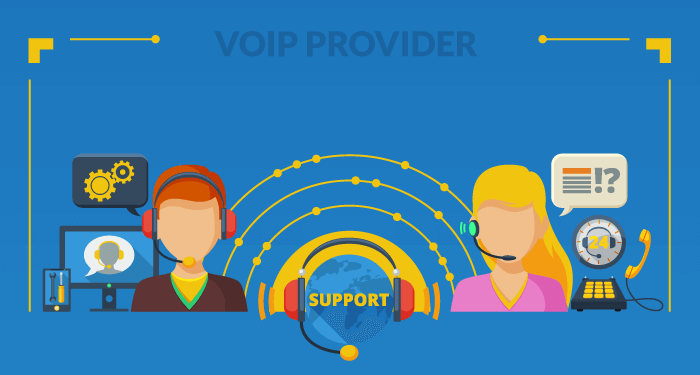Is your existing phone service effectively supporting your communication needs? If not, it may be time to change VoIP providers.
This article will discuss when switching to another service is necessary and how to do it. So, let’s jump in.
Why Change VoIP Providers?
It’s important to note that not all VoIP services are created equal. Some vendors offer users advanced features and better pricing, while others deliver 24/7 global customer support and greater reliability.
Since the market is saturated with many different VoIP products, finding the right one that fits all your needs may be challenging for some. So, what happens if you sign up with a provider that falls short? Or, what if your communication needs change and your existing service no longer supports your goals?
In these cases, you must change your VoIP provider to sustain business growth, optimize your phone system, and maintain effective communication. This way, you get out of a low-quality service and improve the functionality of your network.
Related: What is Hosted VoIP?
7 Signs it’s Time to Switch Services
So, how do you know when to change VoIP providers? Here are 7 reasons to switch your phone service ASAP:
- High, recurring monthly bills
- Poor voice and call quality
- Lack of global country coverage and call management features
- Unreliable, unresponsive customer and technical support
- Issues with network connectivity and reliability that lead to an increase in dropped calls
- Long-term contracts or commitments with minimal value
- Growing need for a flexible and scalable phone solution with high uptime
These are all major signs that your current vendor is holding your business back. Not only is the service hindering your business’s ability to grow, but it’s also preventing you from accessing the many benefits of VoIP. This means it is time to move to a new service that can offer you more while charging less.

How to Change VoIP Providers: 5 Simple Steps
You can switch VoIP providers in the following straightforward steps:
1. Evaluate Current Service
Start by analyzing your current service. What does it do well? What do you wish you could change or add? You can determine your pain points and priorities by evaluating your current service. Make sure to write down your service analysis, as it will come in handy for the provider research phase (more below).
2. Identify Your Communication Needs
Next, you must identify gaps in your system and what you need to improve caller experience. This will not only allow you to quickly narrow down your search but also ensure you get the best service based on your specific needs.
Here are some questions to help you determine your needs:
• Overall Budget – How much are you willing to spend on equipment, features, add-ons, monthly/annual plans, etc.?
• Desired Services & Features – What is the primary use of your current VoIP service? What services and features do you consider “must-have” vs “nice-to-have”? Which ones can you live without?
• Current Setup – What does your current setup look like? Does it meet the minimum VoIP requirements (adequate bandwidth, stable connection, etc.)? Do you have broken or damaged equipment? How do you plan on deploying your new service? Will it be hosted in the cloud or on-premise?
• Number Porting vs New Phone Number – Do you want to keep your existing business phone number by porting it to a new vendor? Or, are you planning on selecting a new one when you change VoIP providers? And if you want a new one, will it be a local, toll-free or international phone number?
• Commitment & Activation Times– Are you currently stuck in a long-term contract? If so, when does it end or do you plan to break it? How fast do you need a new service to activate?
• Call Traffic Logistics – How many lines or users do you need? What is your average number of calls? Do you see this number increasing? And how does your call traffic typically behave (does it fluctuate or is it consistent)?
In addition to the list above, it’s also essential to consider your business goals, particularly expansion plans. This way, you know that your new service can support your future growth.
3. Research and Select a VoIP Provider
To successfully change VoIP providers and improve your system in the process, research a variety of available services. And remember to compare their service offerings to the needs and pain points you identified in the first 2 steps of this process.
On top of that, pay attention to:
- Pricing models and hidden/setup fees
- Specific VoIP requirements and equipment compatibility
- Service activation times
- Available services, features, and add-ons
- VoIP uptime guarantee, network reliability, and crisis management initiatives
- Long-term contract requirements
- Service Level Agreements (SLA)
- Customer and technical support offerings
- Telecommunications and industry experience
- Case studies and customer reviews
Now, this step may take a while to see through, as it involves in-depth research. But, it is crucial because it helps you find a reliable solution that’s right for your business. And if you’re struggling to pick between a few services, book consultations to get an even better idea of how they can help your business.
4. Notify Your Current Provider
If you plan on getting an entirely new service and phone number, talk with your current vendor about your plans to change VoIP providers. This way, you know if they charge any termination fees and you can determine a service end date.
On the other hand, if you plan to port your current number to a new service, notifying your provider helps you avoid delays, understand next steps, and, again, allows you to set up a service end date.
Whatever route you take, it’s extremely important that you maintain your current phone service until the activation or porting process is complete. This ensures that you maintain contact with your customers and business continuity.
5. Installing your New Service
While porting your number may take an extended period of time, getting an entirely new service may be fully operational the same day you sign up.
In most cases, installing VoIP doesn’t require any additional equipment. But, the specific VoIP setup process depends on your provider, existing infrastructure, deployment method, and what equipment you want to use.
For instance: If you plan on using softphones for business communication, simply download your provider’s softphone to an IP-enabled device. Then, connect it to your service using your login information. However, using your existing hardware, such as IP and legacy phones, requires more setup. This is because they need to be physically connected to your router or a gateway.
Once you’ve configured your hardware and software, make sure to add your desired users and set up advanced features such as:
- Call routing and forwarding destinations
- IVR and call flows
- Voicemail
- Caller ID management
- Call recording and so on.
Change VoIP Providers to Improve Efficiency
As you can see, moving to a new provider can make all the difference to the quality and efficiency of your business VoIP system.
United World Telecom offers enterprise-grade VoIP services and phone numbers for businesses worldwide. After 26 years of telecom experience, we’ve established long-term relationships with reliable Tier-1 carriers across the globe. This enables us to deliver high-quality voice services at affordable rates.
And we also provide number porting services if you want to keep your current business phone number. Simply fill out our number porting form to get started.
To learn more, speak with our representatives today over the phone or online! We’re here to help.


